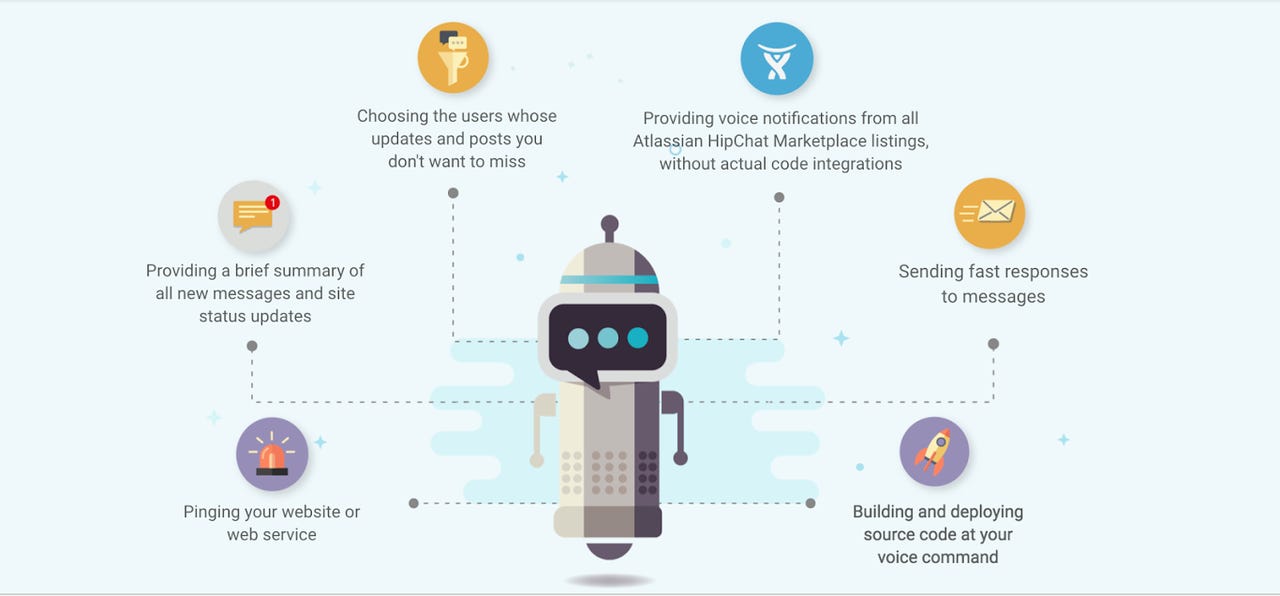HipChat integrates with a proactive version of Amazon's Alexa


HipChat
As its competition from the likes of Microsoft and Slack heats up, Atlassian's workplace chat platform HipChat is rolling out innovations that, the company argues, help set it apart by offering "full-stack collaboration."
Featured
The company on Wednesday announced a new integration with Amazon Echo -- the first of any integration that allows Alexa to initiate conversations. Built by the software developer SoftServe using the HipChat API, the integration allows a user to connect Alexa to their HipCat room and teach Alexa to perform simple tasks.
It also allows Alexa to proactively give notifications from HipChat rooms. For instance, a HipChat user could use Alexa to get a notification if their website goes down and then instruct Alexa to deploy a previous version. Alexa's open API leaves room for customization of commands.
"HipChat's really focused on notifications and covering all the surfaces you have with you," Steve Goldsmith, GM of HipChat explained to ZDNet. "Every time you're looking at one of those surfaces, we've got you covered... What we don't have coverage of is time away from keyboard or surface mode... That's where that critical, proactive voice notification tool fits in."
With the ultimate goal of helping enterprise teams be more productive, HipChat is interested in allowing teams to "define how they define teamwork, and developers define how they can use that tool to solve specific problems," Goldsmith said.
Atlassian has worked on giving developers that flexibility through its API, HipChat Connect, which gives developers a full UI framework. Since its launch last year, more than 200 integrations have been rolled out.
"We're really focused on democratization of technology, how do you get something into the hands of everybody in your company," Goldsmith said. "We think voice is going to be an exciting part of that -- not everybody in your company is going to be comfortable typing all the time or even clicking into applications."
Meanwhile, just about two months after launching its group videoconferencing capabilities, HipChat is updating the feature, increasing its video chat and screen sharing participant limit to 20 teammates.
There are several other improvements, including the addition of a navigation bar for viewing and adding participants. The new version also allows users to change the layout of their video chat, enabling them to "pin" different users to the main stage. There's also a new "raise your hand" function that lets users indicate they're ready to talk without interrupting anyone. Additionally, users can now see the quality of their call and connection to ensure that other participants can see and hear them.
As with the Alexa integration, Goldsmith stressed that HipChat's goal for its updated videoconferencing functionality came down to "democratization."
"We're making this easy and accessible for everybody and solving those pain points for adoption," he said.
This approach, Goldsmith said, should set HipChat apart in an increasingly competitive space. Slack is still growing quickly and securing key partnerships with firms like Salesforce and IBM. Meanwhile, Microsoft is about to launch its Slack competitor, Skype Teams.
Within that marketplace, only Microsoft competes with Atlassian in terms of offering a comprehensive collaboration solution, Goldsmith said -- one that encompasses team collaboration, project management content, and communication.
"The difference between Atlassian and Microsoft in general is that we are typically team-driven -- teams adopt our solution to make the team more productive," he said, "where Microsoft has kind of been at an individual level, whether that's with individual productivity tools like Office or selling to the CIO level."